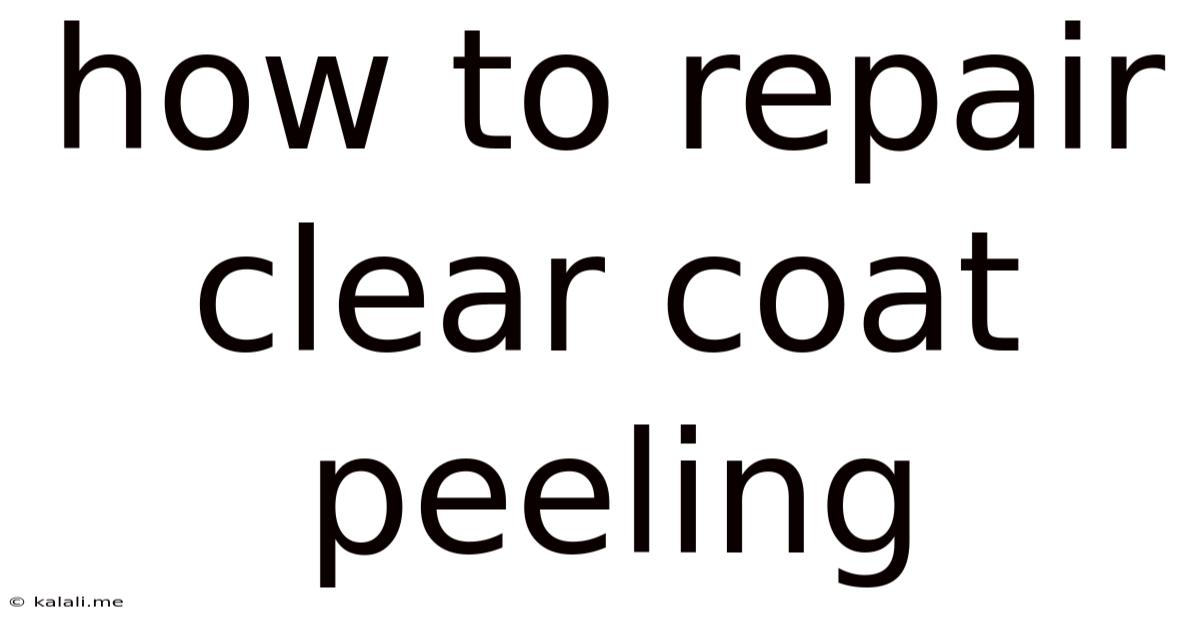How To Repair Clear Coat Peeling
Kalali
Jun 10, 2025 · 4 min read

Table of Contents
How to Repair Peeling Clear Coat: A Comprehensive Guide
Meta Description: Dealing with peeling clear coat? This comprehensive guide provides step-by-step instructions and helpful tips on how to repair the damage, restoring your car's paint to its former glory. Learn about prepping the surface, applying primer and clear coat, and achieving a professional-looking finish.
A peeling clear coat is more than just an eyesore; it's a sign of underlying damage that can lead to further rust and deterioration if left unaddressed. While a complete repaint might seem like the only option, repairing the peeling clear coat yourself is often achievable with patience and the right tools. This guide will walk you through the process, from assessment to final polishing.
Assessing the Damage
Before you start, carefully inspect the affected area. Determine the extent of the peeling. Is it just a small area, or is it widespread? The size of the damaged area will dictate the scope of your repair. For extensive damage, professional help might be more cost-effective. Also, check for any rust underneath the clear coat. Rust removal is crucial before any repair, as it can compromise the longevity of your work.
Gathering Your Supplies
You'll need several supplies to complete this repair. This list isn't exhaustive, but it covers the essentials:
- Sandpaper: Various grits (e.g., 200, 400, 600, 1000, 2000) for sanding and smoothing.
- Masking tape and paper: To protect areas you don't want to be affected by paint or sanding.
- Tack cloth: For removing dust and debris.
- Primer: Specifically designed for automotive use.
- Clear coat: Choose a high-quality automotive clear coat for optimal durability and shine.
- Spray gun (optional but recommended): Provides a smoother, more even finish compared to aerosol cans. If using an aerosol can, ensure adequate ventilation.
- Safety glasses and respirator: Essential for protection against paint fumes and airborne particles.
- Solvent/Thinner: For cleaning tools and surfaces.
- Rubbing compound and polishing compound: To achieve a smooth, glossy finish.
- Microfiber cloths: For wiping and polishing.
- Putty knife or scraper (for severe peeling): Gently remove loose clear coat.
Repairing the Peeling Clear Coat: A Step-by-Step Guide
-
Preparation: Thoroughly clean the affected area with soap and water. Allow it to dry completely. Use a putty knife or scraper to carefully remove any loose or flaking clear coat. Be gentle to avoid scratching the underlying paint.
-
Sanding: Start with a coarser grit sandpaper (e.g., 200 grit) to remove any remaining loose paint or imperfections. Gradually move to finer grits (400, 600) to smooth the surface. Always sand in one direction to avoid swirl marks.
-
Cleaning: Use a tack cloth to remove any dust or debris from the sanded area.
-
Priming (if necessary): If you've sanded down to the base coat, applying a primer is crucial. This creates a uniform surface for the clear coat to adhere to. Allow the primer to dry completely according to the manufacturer's instructions. Lightly sand the primed area with fine-grit sandpaper (e.g., 600 grit) to create an even surface.
-
Applying Clear Coat: If using a spray gun, thin the clear coat according to the manufacturer's directions. Apply several thin coats, allowing each coat to dry slightly before applying the next. Avoid heavy coats to prevent runs and drips. With aerosol cans, follow the instructions on the can carefully.
-
Drying and Curing: Allow the clear coat to dry and cure completely. This process can take several days or even weeks, depending on the product and environmental conditions.
-
Wet Sanding and Polishing: Once the clear coat is fully cured, wet sand the surface using progressively finer grits of sandpaper (e.g., 1000, 2000). This removes any imperfections and creates a smooth surface. Finish with rubbing compound and polishing compound to achieve a high-gloss shine.
Maintaining Your Car's Paint
Regular car washing and waxing are essential for protecting your car's paint and preventing future clear coat peeling. Avoid parking your car under direct sunlight for extended periods and consider using a quality paint sealant for added protection.
By following these steps, you can successfully repair peeling clear coat and restore your car's paint to its former glory. Remember safety first and always refer to the manufacturer's instructions for your specific products. If you’re unsure about any step, it’s always best to consult a professional auto body repair shop.
Latest Posts
Latest Posts
-
How Many Square Yards In One Acre
Jul 02, 2025
-
What Is 2 3 Of 3 Quarts
Jul 02, 2025
-
Courtesy Is Cumbersome To Them That Know It Not
Jul 02, 2025
-
How Far Is 220 Yards On A Track
Jul 02, 2025
-
What Is The Shortest Chapter In The Bible
Jul 02, 2025
Related Post
Thank you for visiting our website which covers about How To Repair Clear Coat Peeling . We hope the information provided has been useful to you. Feel free to contact us if you have any questions or need further assistance. See you next time and don't miss to bookmark.